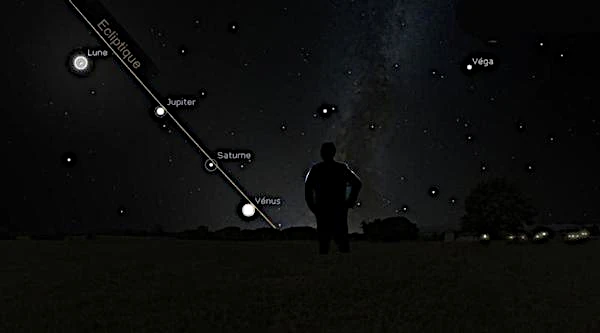
The plane of the ecliptic serves as the theater where the millennia-old dance of the planets around our star unfolds. This plane, defined by Earth's orbit, is the reference for describing the apparent movements of celestial bodies. As demonstrated by Johannes Kepler (1571-1630) in his laws of planetary motion, each planet traces an ellipse with the Sun at one of its foci, while remaining remarkably close to this imaginary plane (within a few degrees).
This near-coplanarity is not coincidental: it results from the initial conditions of the solar system's formation 4.6 billion years ago, when the protosolar nebula flattened into a disk due to its rotation, as theorized by Pierre-Simon Laplace (1749-1827) in his nebular hypothesis. The planets then formed by accretion within this disk, inheriting its orientation.
N.B.:
The ecliptic is the reference plane of the solar system, defined by Earth's orbit. Inclined at 23°26' relative to the celestial equator, it serves as the basis for the ecliptic coordinate system (λ,β) used to describe planetary positions. Solar system bodies generally orbit near this plane (<5° inclination), except for comets and some trans-Neptunian objects.
Although planetary orbits appear nearly circular and coplanar, they exhibit subtle variations that enrich the celestial choreography:
These orbital parameters evolve over geological timescales due to mutual gravitational perturbations, as calculated by Joseph-Louis Lagrange (1736-1813) in his work on the stability of the solar system. Their combination produces changing celestial configurations, such as planetary conjunctions or transits.
Orbital resonances occur when two celestial bodies exert periodic gravitational influence on each other, creating a simple ratio between their orbital periods (e.g., 3:2 for Neptune and Pluto). These configurations, studied by Pierre-Simon Laplace (1749-1827), stabilize orbits and explain structures like the Kirkwood gaps in the asteroid belt or the resonance chain of the TRAPPIST-1 system.
Some planets maintain precise mathematical relationships in their orbital periods, creating repetitive patterns:
| Objects Involved | Period Ratio | Observable Consequence | Stability (Timescale) | Dominant Mechanism |
|---|---|---|---|---|
| Neptune ↔ Pluto | 3:2 | Protects Pluto from Neptune's gravitational perturbations | > 100 million years | Mean-motion resonance lock |
| Jupiter ↔ Saturn | 5:2 (approximate) | Creates gaps in the asteroid belt (Kirkwood gaps) | Tens of millions of years | Secular perturbations |
| Io ↔ Europa ↔ Ganymede | 1:2:4 | Maintains Io's volcanic activity through tidal effects | Stable for 4.5 Ga | Laplace resonance (3-body coupling) |
| Enceladus ↔ Dione | 2:1 | Responsible for Enceladus' internal heating and geysers | Stable over 100 Ma | Dione-forced eccentricity |
| Kuiper Belt (objects) | 2:3, 1:2, 2:5 with Neptune | "Popcorn" structure of the Kuiper Belt | Variable (10 Ma to 1 Ga) | Early planetary migration |
| Triton (Neptune's moon) | Retrograde (inclination 157°) | Decaying orbit leading to future destruction | < 100 million years | Tidal braking |
| TRAPPIST-1 System | Resonance chain 24:15:9:6:4:3:2 | Stabilizes 7 planets over 100 Ma | Short-term stable | Tight gravitational coupling |
| Saturn's Rings | Resonances with Mimas (2:1, 3:1) | Creates Cassini and Encke divisions | Tens of millions of years | Orbital perturbations |
| (90) Antiope (binary asteroid) | Orbital period = rotation period | Maintains stable binary structure | Stable over 100,000 years | Rock equilibrium |
| Nereid (Neptune's moon) | Extremely eccentric orbit (e=0.75) | Possible captured object in temporary resonance | Unstable long-term | Chaotic interactions |
Sources: NASA JPL Small-Body Database (2025), The Astrophysical Journal (Murray & Dermott, 2024), Astronomy & Astrophysics (exoplanetary resonances, 2023). Data calculated with NIEOM and MERCURY dynamic models.
The night sky carries subtle clues about our position in space. The Moon's phase indicates the Sun's hidden position below the horizon. Similarly, Venus—the "morning star" or "evening star"—traces the Sun's apparent path in the twilight sky. These celestial markers outline for us, without immediate awareness, the invisible contours of the ecliptic.
Our daily perception deceives us: standing on Earth's surface, we feel an absolute verticality, yet our planet is tilted 23°26' relative to the solar system's plane. This tilt, combined with Earth's rotation, masks our active participation in the planetary dance. We must mentally shift our perspective—as if straightening a map—to realize that we indeed share this plane with all the planets, like a flat disk gliding through cosmic immensity.
When this awareness dawns, a profound emotion seizes us. We suddenly understand that our solar system, with its aligned planets, plunges into the darkness of limitless space. Earth, without physical sensation, carries us through this void at dizzying speeds, while performing its dual rotation: on its axis in 24 hours, and around the Sun in one year.
This terrestrial motion is part of a much grander choreography:
Each rotation, each revolution, fits into an overall movement that is vertigo-inducing. Unknowingly, we participate in this fantastic ballet, where every celestial body, from planets to galaxies, performs its part in the cosmic symphony.
| Movement | Speed | Period | Distance Traveled |
|---|---|---|---|
| Earth's rotation | 1,670 km/h | 23h 56m | 40,075 km (circumference) |
| Revolution around the Sun | 107,200 km/h (29.8 km/s) | 365.25 days | 940 million km |
| Sun's galactic orbit | 828,000 km/h (230 km/s) | 225-250 million years | 50,000 light-years |
| Movement toward the Great Attractor | 2.27 million km/h (630 km/s) | Unknown | Direction: Centaurus constellation |
Sources: NASA/JPL Solar System Dynamics, Gaia Mission (ESA), The Astrophysical Journal (2023)
Understanding the mechanics of the ecliptic is like holding a roadmap of the solar system. Space missions leverage this knowledge:
As Carl Sagan (1934-1996) noted: "We are all travelers on this spaceship called Earth, navigating through the cosmos along the path traced by the ecliptic." This perspective reminds us of our place in the universe, where even the most regular planetary motions hide fascinating complexity, shaped by 4.6 billion years of dynamic evolution.